Earendel (WHL0137-LS) is the earliest and most distant star discovered to date. It lies at a comoving distance of 28 billion light-years from Earth. It is almost twice as distant as the previous record holder, Icarus (MACS J1149 Lensed Star 1). Earendel lies in the constellation Cetus. It was discovered by the Hubble Space Telescope through a gravitational lens. The discovery was reported on March 20, 2022.
Hubble was able to detect Earendel because the star’s light was lensed by the galaxy cluster WHL0137-08, which lies between us and the star. The massive cluster acted like a magnifying glass, amplifying the star’s light between 1,000 and 40,000 times.
Earendel’s host galaxy, catalogued as WHL0137-zD1, was nicknamed “Sunrise Arc” because gravitational lensing bent its light into the shape of a long crescent. The two red dots visible on either side of WHL0137 Lensed Star are both the same star cluster whose light has been bent into two separate images that mirror each other.
The cluster is believed to be at least 10 million years old. It is gravitationally bound and likely still exists. It shows us what the Milky Way’s globular clusters may have looked like when they formed soon after the Big Bang.
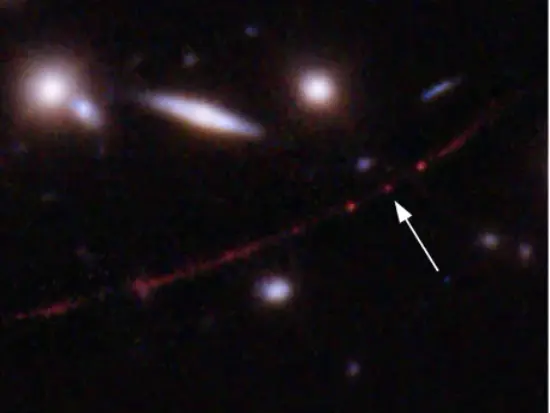
The most distant star yet seen, called Earendel, is indicated by an arrow in the inset of this image from the Hubble Space Telescope that captured the star from 12.9 billion light-years away using a gravitational lens. Image: NASA, ESA, Brian Welch (JHU), Dan Coe (STScI), Alyssa Pagan (STScI)
Distance
Earendel has a redshift of 6.2. The light detected from the star was emitted only 900 million years after the Big Bang, and it reached Earth 12.9 billion years later. However, the comoving distance – which takes into account the expansion of the universe in the time since the light was emitted – is now 28 billion light years.
When the starlight from Earendel was emitted, the star was only 4 billion light-years away from what became the Milky Way galaxy. As the universe expanded during the 12.9 billion years that it took for the light to reach Earth, the star would now be 28 billion light years away.
The previous record holder for the most distant single star – Icarus (MACS J1149 Lensed Star 1) – has a comoving distance of 14.4 billion years with a redshift of 1.49. Its light was emitted 9.34 billion years ago, about 4.4 billion years after the Big Bang.
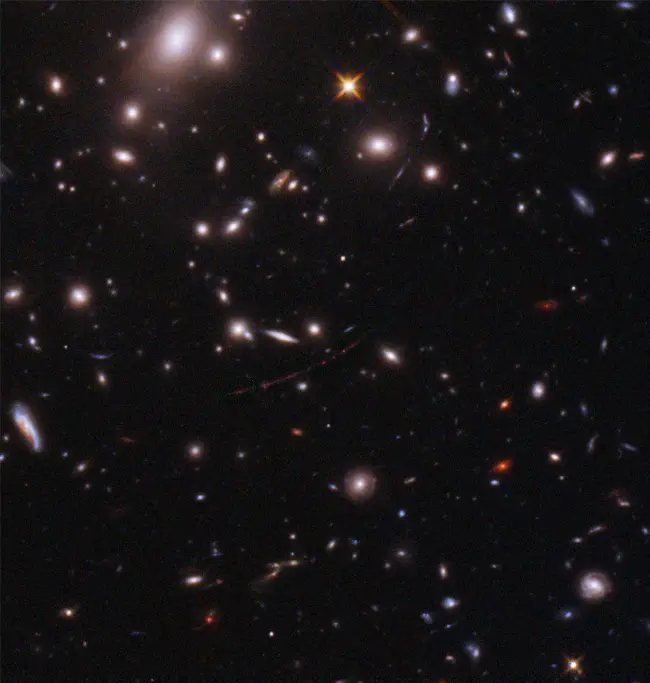
NASA’s Hubble Space Telescope has established an extraordinary new benchmark: detecting the light of a star that existed within the first billion years after the universe’s birth in the big bang – the farthest individual star ever seen to date. The find is a huge leap further back in time from the previous single-star record holder; detected by Hubble in 2018. That star existed when the universe was about 4 billion years old, or 30 percent of its current age, at a time that astronomers refer to as “redshift 1.5.” Scientists use the word “redshift” because as the universe expands, light from distant objects is stretched or “shifted” to longer, redder wavelengths as it travels toward us. The newly detected star is so far away that its light has taken 12.9 billion years to reach Earth, appearing to us as it did when the universe was only 7 percent of its current age, at redshift 6.2. The smallest objects previously seen at such a great distance are clusters of stars, embedded inside early galaxies. Image: NASA, ESA, Brian Welch (JHU), Dan Coe (STScI). Image processing: NASA, ESA, Alyssa Pagan (STScI)
Star type
Earendel is a hot blue B-type star with a mass between 50 and 100 times that of the Sun and a surface temperature of at least 20,000 K. Beyond that, its properties are uncertain. Stars with such high mass do not live very long lives. They burn through their supply of hydrogen quickly and evolve away from the main sequence to become supergiants. Earendel likely went out as a supernova only a few million years after forming.
There is a small probability that Earendel is a population III star. Population III stars are a hypothetical group of exceptionally massive, hot, luminous stars that existed when the universe was very young. These stars contained almost no metals. They were made almost entirely of primordial hydrogen and helium. They are believed to have started the production of chemical elements heavier than hydrogen, essential for the formation of planets.
The earliest generation of stars formed about 100 million years after the Big Bang, which means that Earendel was preceded by one or two generations of stars. Heavier elements did not exist before these first stars went out as supernovae.
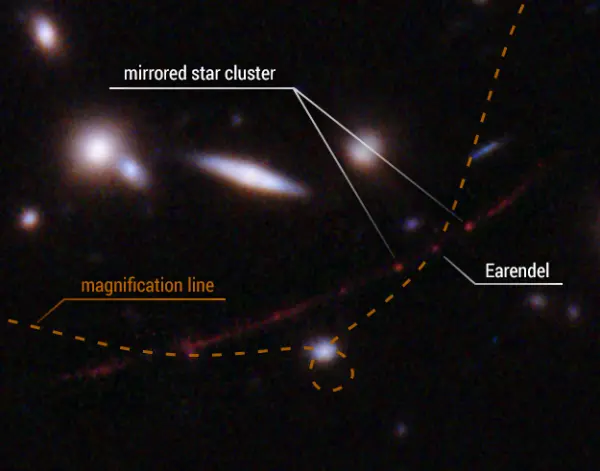
The Sunrise Arc galaxy with lensed star Earendel. Image: NASA, ESA, Brian Welch (JHU), Dan Coe (STScI). Image processing: NASA, ESA, Alyssa Pagan (STScI)
The detection of the first generation of stars is one of the most important objectives of the James Webb Space Telescope, launched on December 25, 2021. The space telescope has the sensitivity to allow a more detailed analysis of Earendel’s stellar spectra and detect any companions. The data collected with it will allow scientists to constrain Earendel’s mass, radius, temperature, and age, as well as to confirm if it is a single star. Astronomers expect that the star will stay magnified for years to come. Observations with the JWST will provide them with a better look at Earendel and more data to pinpoint its properties.
If astronomers find that Earendel is indeed made only of primordial hydrogen and helium, this will be the first detection of a Population III star.
James Webb Space Telescope (JWST) image
Earendel was imaged by NASA’s James Webb Space Telescope in 2023. Webb’s Near-Infrared Camera (NIRCam) has revealed the faraway star to be a massive B-type star about twice as hot and a million times as luminous as the Sun.
Like Hubble, Webb was able to detect Earendel due to gravitational lensing. Even though other features of the star’s host galaxy are lensed multiple times, Earendel is only visible as a single point of light. From this, astronomers deduced that the star is exceptionally small and is magnified by a factor of at least 4,000. It is seen 1 billion years after the Big Bang.
Even though researchers did not expect the JWST to reveal any companions, the spectrum of Earendel may indicate the presence of a cooler, redder companion.
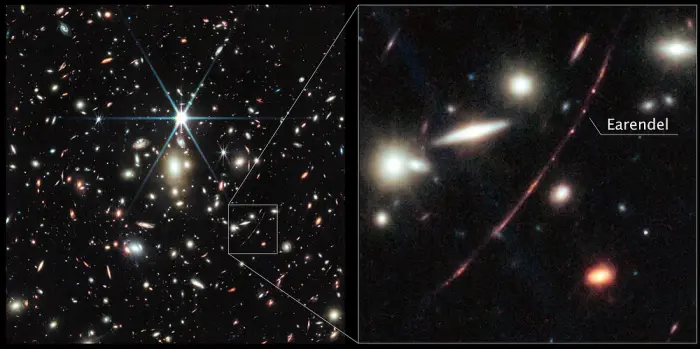
This image from the NASA/ESA/CSA James Webb Space Telescope shows a massive galaxy cluster called WHL0137-08, and at the right, an inset of the most strongly magnified galaxy known in the Universe’s first billion years: the Sunrise Arc. Within that galaxy is the most distant star ever detected, first discovered by the NASA/ESA Hubble Space Telescope.Webb’s NIRCam (Near-Infrared Camera) instrument reveals the star, nicknamed Earendel, to be a massive B-type star more than twice as hot as our Sun, and about a million times more luminous. Stars of this mass often have companions. Astronomers did not expect Webb to reveal any companions of Earendel since they would be so close together and indistinguishable on the sky. However, based solely on the colours of Earendel detected by Webb, astronomers think they see hints of a cooler companion star. Image credit: NASA, ESA, CSA, D. Coe (AURA/STScI for ESA), Z. Levay (CC BY 4.0)
The James Webb telescope showed other new details in the Sunrise Arc galaxy, including young stellar nurseries and older star clusters, some of which are only 10 light-years in diameter. The region where new stars are formed is believed to be less than 5 million years old. It appears elongated in the Hubble and James Webb images.
Earendel and the Sunrise Arc galaxy were also imaged by Webb’s NIRSpec (Near-Infrared Spectrograph). Scientists are still analyzing the data obtained with it, which will provide them with new insights into the composition and distance of the galaxy.
Earendel is not the only distant star studied by Webb. In 2023, the space telescope found the first individual red giant star at a distance greater than 1 billion light-years from Earth. Nicknamed Quyllur (the Quechua word for “star”), the giant is lensed by the El Gordo galaxy cluster, located over 7 billion light-years away in the constellation Phoenix. Quyllur was observed 3 billion years after the Big Bang.
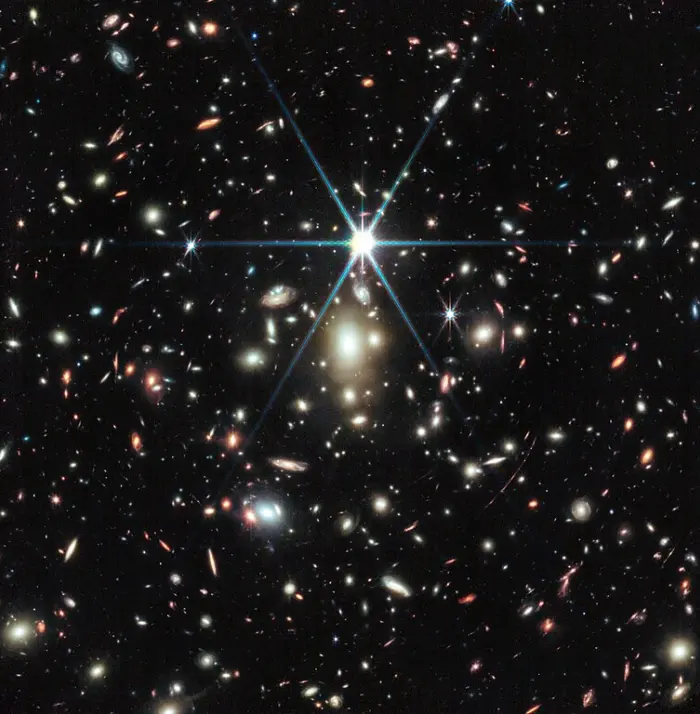
This image from the NASA/ESA/CSA James Webb Space Telescope of a massive galaxy cluster called WHL0137-08 contains the most strongly magnified galaxy known in the Universe’s first billion years: the Sunrise Arc, and within that galaxy, the most distant star ever detected. The star, nicknamed Earendel, was first discovered by the NASA/ESA Hubble Space Telescope. Follow-up observations using Webb’s NIRCam (Near-Infrared Camera) reveals the star to be a massive B-type star more than twice as hot as our Sun, and about a million times more luminous. Earendel is positioned along a ripple in spacetime that gives it extreme magnification, allowing it to emerge into view from its host galaxy, which appears as a red smear across the sky. The star is detectable only due to the combined power of human technology and nature via an effect called gravitational lensing. While other features in the galaxy appear multiple times due to the gravitational lensing, Earendel only appears as a single point of light even in Webb’s high-resolution infrared imaging. Based on this, astronomers determine the star is magnified by a factor of at least 4000, and thus Earendel is extremely small – the most distant stellar source ever detected. Image credit: NASA, ESA, CSA, D. Coe (AURA/STScI for ESA), Z. Levay (CC BY 4.0)
Facts
The discovery of WHL0137-LS, a star at redshift 6.2, was reported on March 30, 2022. The study was published in the journal Nature. Earendel was found by a team led by astronomer Brian Welch of the Johns Hopkins University in Baltimore. It was detected in Hubble’s exposures taken on June 7, 2016, July 17, 2016, November 4, 2019, and November 27, 2019.
The data was collected during Hubble’s Reionization Lensing Cluster Survey (RELICS) program, led by co-discoverer Dan Coe of the Space Telescope Science Institute (STScI). The RELICS program aimed at discovering high-redshift galaxies that existed in the early universe. The observations that led to the discovery of the highest redshift star focused on massive clusters of galaxies that acted as lenses for high-redshift galaxies.
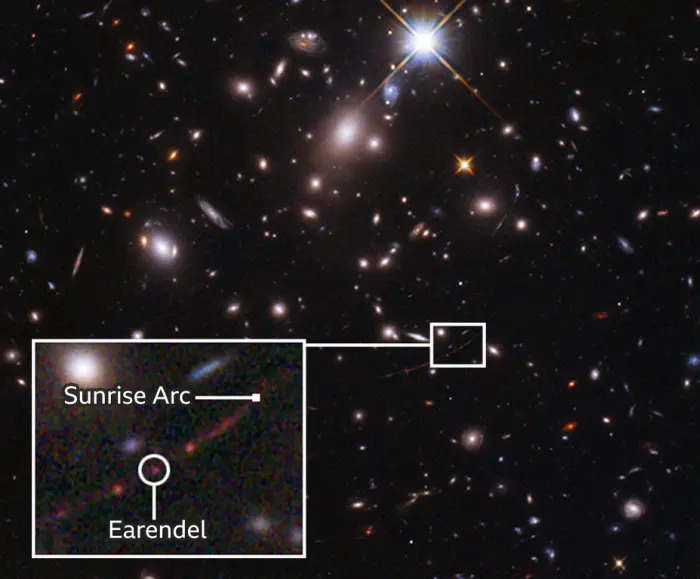
Earendel, a distant star, and the Sunrise Arc, the galaxy within which it was found. Image credit: NASA, ESA, Brian Welch (JHU), Dan Coe (STScI), processing: NASA, ESA, Alyssa Pagan (STScI)
Name
The name Earendel comes from the Old English name for “rising light” or “morning star.” The name is also a reference to Eärendil the Mariner, a half-elven character in J. R. R. Tolkien’s The Silmarillion (1977) and Unfinished Tales (1980). In Tolkien lore, Eärendil carries the last of the Silmarils (jewels composed of the light of the Two Trees), which becomes the Morning Star.
The star was named by the researchers who discovered it. They explained that it was a good fit for a star that existed during the Cosmic Dawn, a period when the first stars, black holes and galaxies started to form. The period lasted from about 50 million years to one billion years after the Big Bang.
Location
Earendel lies in the central region of the constellation Cetus, above the imaginary line connecting Zeta and Theta Ceti. With an apparent magnitude of 27.2, the star is invisible even in the largest amateur telescopes.
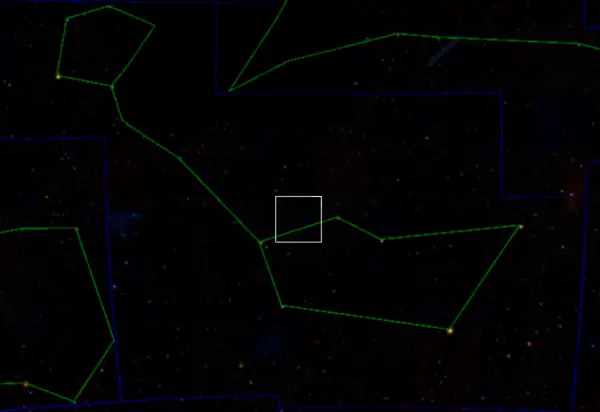
The location of Earendel in Cetus, image: Wikisky
Constellation
Earendel is located in the constellation Cetus. In Greek mythology, Cetus is associated with the sea monster from the myth of Andromeda. It was one of the 48 Greek constellations, catalogued by the Greco-Roman astronomer Ptolemy in his Almagest in the 2nd century CE.
Cetus is the fourth largest constellation in the sky (after Hydra, Virgo, and Ursa Major), occupying 1,231 square degrees of the mostly southern sky. It is one of the 15 equatorial constellations, visible from most locations for at least part of the year. Despite its size, Cetus does not stand out in the night sky. Only two of its stars – Diphda and Menkar – shine brighter than magnitude 3.00.
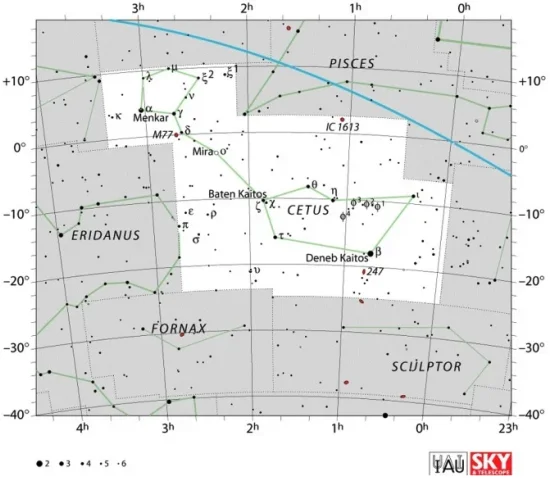
Cetus constellation map by IAU and Sky&Telescope magazine
Cetus hosts many interesting stars, among them Tau Ceti, the nearest single Sun-like star to Earth, UV Ceti (Luyten 726-8B), a nearby flare star, and Mira (Omicron Ceti), a famous pulsating variable red giant.
Cetus contains several relatively bright deep sky objects. These include the barred spiral galaxy Messier 77 (Cetus A), the spiral galaxies NGC 247, NGC 1042, NGC 1035 and NGC 1055, the irregular dwarf galaxy IC 1613, and the planetary nebula NGC 246 (the Skull Nebula).
The best time of the year to see the stars and deep sky objects in Cetus is during the month of November, when the constellation rises high above the horizon in the evening sky. The entire constellation is visible from locations between the latitudes 70° N and 90° S.
The 10 brightest stars in Cetus are Diphda (Beta Ceti, mag. 2.02), Menkar (Alpha Ceti, mag. 2.53), Eta Ceti (mag. 3.446), Kaffaljidhma (Gamma Ceti, mag. 3.47), Tau Ceti (mag. 3.50), Iota Ceti (mag. 3.562), Theta Ceti (mag. 3.60), Baten Kaitos (Zeta Ceti, mag. 3.742), Upsilon Ceti (mag. 3.95), and Delta Ceti (mag. 4.06). The pulsating variable star Mira (Omicron Ceti, mag. 2.0 – 10.1) is sometimes among the brightest stars in the constellation and at other times it is invisible to the naked eye.
Earendel – WHL0137-LS
| Apparent magnitude | 27.2 |
| Distance | 28 billion light years |
| Mass | 50 – 100 M☉ |
| Temperature | >20,000 K |
| Constellation | Cetus |
| Right ascension | 01h 37m 23.232s |
| Declination | –8° 27′ 52.20″ |
| Names and designations | Earendel, WHL0137-LS |